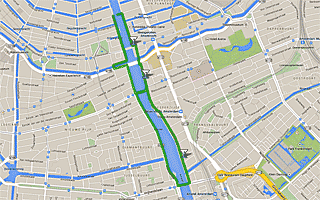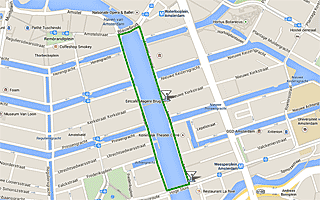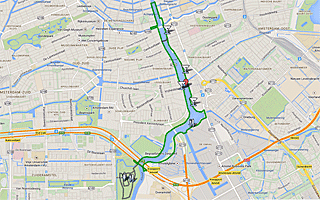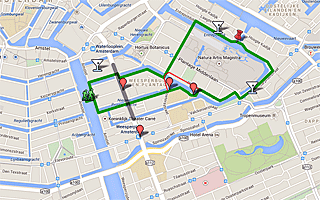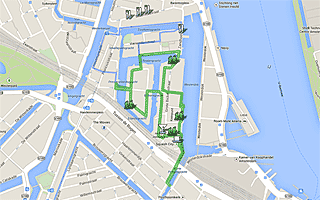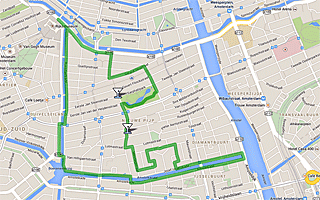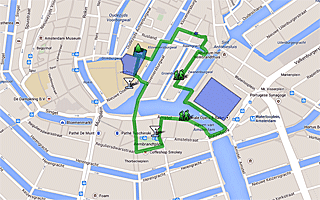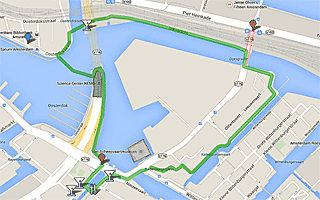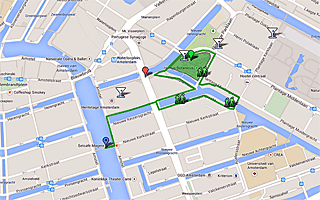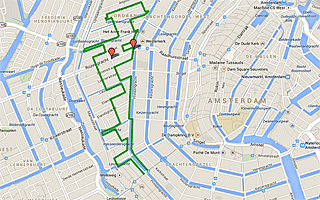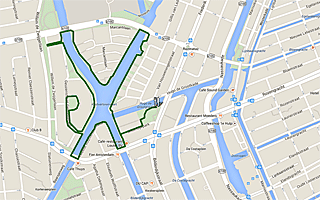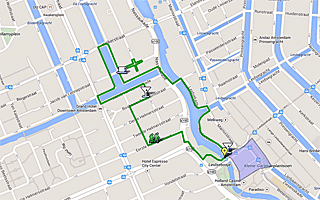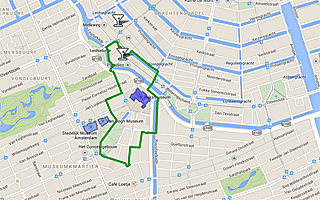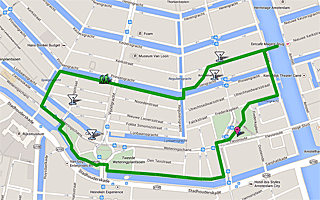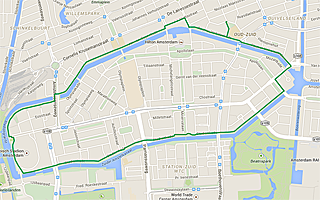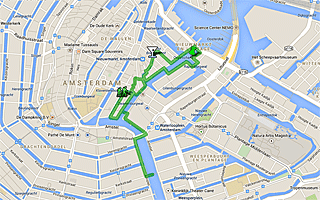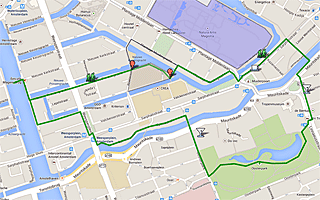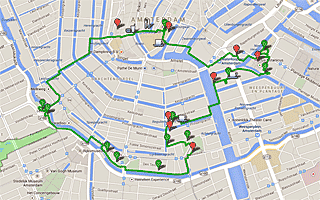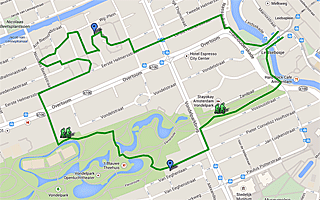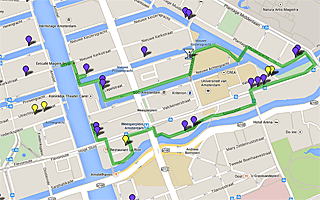Spring is in the air…
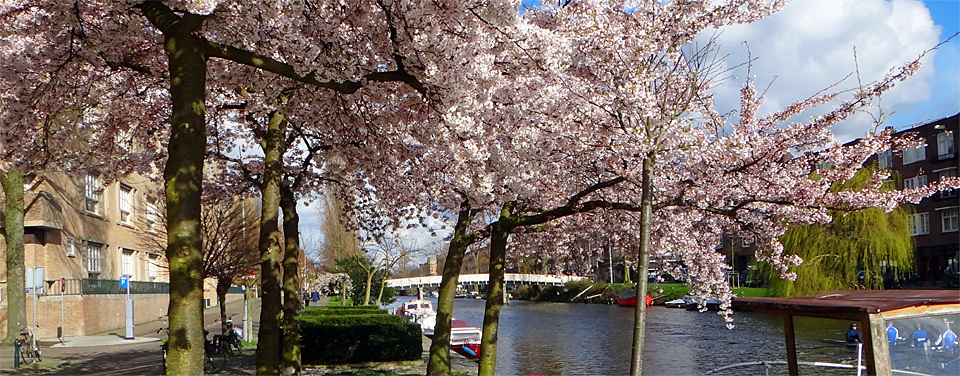
Spring is in the air in Amsterdam
- Walks in Amsterdam in spring
- What you can see in spring in Amsterdam
- Where to quench your thirst in Amsterdam in spring
On the very day that the cold goes out of the wind to be replaced by a breeze that you could almost call warm, and the blackbird flies to the highest point in the street to delight us with his song — out come the Amsterdammers: walking, talking, cycling, boating, gardening, eating, drinking, and above all, enjoying their city.
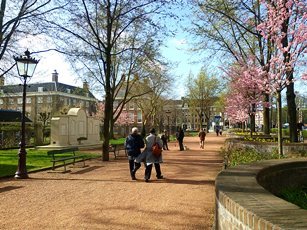
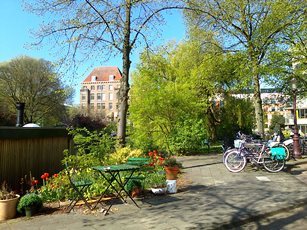
Rather than scurry home after work, many Amsterdammers tend to plonk themselves somewhere in the sun with the newspaper, a book, some friends, and maybe their dinner.
The canals, the abundance of trees and the pavement gardens join forces to give you a lovely leafy walking environment.
Spring walks in Amsterdam
-
Amstel River along the Weesperzijde Walk
The Amstel River is as much the essence of Amsterdam as the canals are, and no self-respecting tourist can return home without having had a stroll along the banks of the Amstel. This is a longer walk of 3 miles (5 km or so) but you can cut it a lot shorter by traversing one of the bridges, at Ceintuurbaan for instance.
However, if you do go the long haul, and walk as far as the Berlagebrug (bridge), you will not regret it. It takes you southwards, along the Amstel River, right on the riverside. On your way back, seeing the central city in the distance, you will get some idea of how Amsterdam appeared from afar in bygone days.
-
Amstel River and Reguliersgracht Walk
Lots to see on this short, round-trip walk, which is stunning on a beautiful morning or evening. During the day it is lovely too but it is more noisy and busy and this spoils its surprising city centre serenity. You can start on the Skinny Bridge (Magere Brug) and then follow the Amstel in a southerly direction. After that, the walk takes you through the Frederiksplein and Falckstraat, both of which are green oases.
This walk is very short and central yet gets you away from ‘the madding crowd’. It is easy to do in the evening and because you'll encounter umpteen bridges with their lovely lights, it's great after dark too.
-
Amstel River Short Walk
A lovely riverside walk in the heart of the city. Despite the short distance, it includes the essence of the city: canals, Theatre Carré, the Hermitage Museum, the upmarket Amstel Hotel, the Skinny Bridge (Magere Brug), the Stopera, and you'll cross the Prinsengracht, Keizersgracht and Herengracht on your way and may glimpse the towers of the Rijksmuseum. It's only about a mile so should take no more than 30 minutes, however, being such a picturesque walk, you may be tempted to dawdle and gaze at the nice vistas.
-
Amstel River Walk
Heading south along the Amstel River has a special feel to it. You leave the city behind and even though you look back at familiar landmarks, the widening river beckons.
At 10 km (6.3 miles), this is a satisfying walk and takes you outside the built-up urban area; it's fantastic to be able to escape the city so easily, just on foot. It's suitable for all seasons too, each season having its distinct appeal.
-
Artis Area and Entrepotdok Walk
A wonderful spring walk, it's not long, only a few miles / kilometres. The many weeping willows along the water are lovely in early spring. You can do this walk morning, noon or afternoon/evening, as long as it's still good and bright. There are some mighty poplars too along the way, two separate stands. The cherry trees are really pretty in early spring of course.
-
Bickerseiland, Prinseneiland, and Realeneiland Walk
Called the ‘Western Islands’ district, this area is made up of three islands of land joined by little bridges. Some parts are very quaint, whereas other stretches face dramatic vistas of modern dockland development, mostly business and residential. All in all, this area is pleasantly secluded, being a kind of cul-de-sac, and on a nice warm day you'll feel the benefit of being surrounded by water.
-
Brouwersgracht, Langestraat, and Herenmarkt Walk
When I think of autumn I see the Brouwersgracht. There's no objective reason for this but this walk does give autumn the pedestal it deserves. It's being able to hug the canal for such lovely long stretches and the cosy feel of the little streets that intersect with the canals. It's lovely on a golden September day but equally enjoyable on a sodden and blustery October evening.
-
Cherry Blossom Quayside Walk
When the cherries are in blossom, this route is a trip! It's an intoxicating wave of cherry after cherry tree, big, small, pink, white, by the water, on the streets, in street-gardens, and in little squares and greens. And all these cherry trees are set against the unique ‘Amsterdamse School’ architecture. Particularly on or around the Jozef Israelskade (quayside) you can admire this unusual style in the residential buildings, schools, and bridges as you wander by.
-
City Hall, Stopera, Zuiderkerk, and University area Walk
Right in Amsterdam's city centre, this short walk of less than 1.5 miles will amaze you by its tranquillity. Although you're just a stone's throw from ‘the action’ you'll feel as if you're in a little village at times. Vary the route according to your mood and energy.
-
Docklands Dijksgracht Walk
Part of Amsterdam's beauty is that it's not all manicured and perfect. This walk is a great example of Amsterdam Raw – its ‘unclipped edges’. Peaceful and lush green for the most part, yet situated in the centre. You'll pass the Maritime Museum, ramble through dockland residential areas finding yourself in leafy bliss on waterside footpaths. The railway is ahead of you in the distance.
-
Hortus Botanicus (Botanic Garden) and surrounding area
This area is called the Plantage which translated means plantation, so I don't need to elaborate on the leafiness. But I will ha ha! Was there ever a small city district so beautifully planted with trees of such considerable age, variety, shade and texture! You'll find plane, lime, beech, elm, cypress, willow, poplar, birch, to mention but a few. Tree experts should love this area because there are lots of rare and mature specimens.
-
IJ Harbour and around via Oranjesluizen (locks)
Not for the faint-hearted! This 15 km (10 mile) tramp will take you to remote places where you need both a good map and a reasonable sense of direction. Although the length of the walk is not hugely strenuous, this route is remarkably rural and remote for a city walk. You'd be well advised to have some emergency nutrition with you, and water if it's a warm day. There is quite a stretch where you won't meet either a shop nor a café.
-
Jordaan South Walk
With street names like Roses Street (Rozenstraat), Eglantine Street (Egelantierstraat), Flower Canal (Bloemgracht), it should be no surprise that this area is blooming. The Jordaan is an area of little canals and streets, little bridges, little houses; everything here has big ‘cute’ appeal. In the morning or evening, it has a restful atmosphere, especially during the weekend.
-
Kostverlorenvaart Walk
This curiously shaped route (see map) represents a lovely walk beside water and trees in the west of Amsterdam. It's almost totally on a traffic-free footpath which gives it its special appeal and you should find it an utterly relaxing experience. You can start somewhere central in the city and walk to the Bilderdijkpark or you can take a tram. This route is only about 10 - 15 minutes on foot from the Jordaan, so it's quite near.
-
Leidse Loop
The bustling Leidseplein can be a pleasant oasis on a nice spring morning. This ‘Leidse Loop’ walk is a mixture of leafy canals and semi-pedestrian streets full of art for the interested passer-by. There's lots to see and enjoy on this walk that loops the Leidseplein.
-
Leidsekade to Da Costakade and back Walk
Take the Leidsekade (quayside) just around the corner from the hubbub of the Leidseplein, start by the American Hotel. Wander along the Leidse, van Lennep, and Da Costa quaysides; nose around in cute residential areas. You're never more than about 15 mins from the Leidseplein and yet you'll feel pleasantly ‘away from it all’. Although not called canals, these quayside ‘kade’ walks are every bit as nice, just not quite so old as the 400-year old canal ring.
-
Maritime Museum and Oosterkerk Walk
Lovely, leafy, waterside walk when you feel like something completely different. Despite being the old shipyard area and housing for the shipyard workers, this area is mainly recent residential architecture. Most of the old buildings were knocked down to make way for modern housing but it still feels authentic and it has been nicely planted with trees of all sorts.
-
Museum Route
A good route because you get to see a lot of the museums in a panorama and from a distance. The Rijksmuseum is wonderful but from Museumplein you can also see the Concertgebouw, the Stedelijk Museum and the van Gogh Museum. Nice too in winter because this walk is nice and spacious and so you get great vistas. Only about 1.5 miles so a doddle really.
Luckily the ‘Rijks’ is open again after a 10-year renovation, and I sincerely hope that all the building pre-fabs and other eyesores around the site will disappear soon. -
Nicolaas Witsenkade to Rijksmuseum Walk
Another lovely spring walk especially if the plane trees have come into leaf. The first part mainly plane trees but after that, from the Wetering Circuit onwards, you get a lovely sweep of weeping willow weeping away into the water. This part has a great backdrop with the Rijksmuseum behind, magnifique.
-
Olympic Stadium Loop Walk
Lengthy and peaceful waterside walk past a great variety of architecture.
During this walk you’ll explore a less-known area just at the edge of the centre where it’s quiet and spacious – wonderful on warm weekends when the city pavements can be thronged with (other) tourists. On this waterside loop you can walk at leisure, find a bench to sit, read, or dream, while enjoying lovely trees, pavement gardens, and interesting architecture along the way. This route goes around the Olympic Stadium, and the round-trip continues beside the water on the way back towards the city centre. You’ll be beside water most of the time and it’s relatively traffic-free and blissfully so in places.
-
Oosterpark, Eastern Islands, and the Kadijken Walk
Roam along leafy waterfronts, take your time in the beautiful Oosterpark, and admire the majestic Tropeninstituut (Institute & Museum of the Tropics) which you'll spot from a distance and can gaze at from many angles. Further along, the old eastern-island harbour area has a mix of wonderful old warehouse buildings and modern constructions, not all to ones taste, but interesting nonetheless. It's a great walking-area with few cars, some nice green areas and water, water, everywhere.
-
Oudeschans and Kromboomsloot area
Nice about this walk is that you can shorten it or just go with the flow and complete the few miles/kilometres. The route takes you along the Amstel, past the Opera City Hall and then down to the oldest area of the city. You'll see lovely old towers, the modern Nemo Science Museum (built like a ship) in the harbour and lots of typical Amsterdam facades and lovely canals along the way.
-
Oudeschans and Nieuwmarkt area walk
This walk and neighbourhood is a breath of tranquility sandwiched as it is between the hectic Nieuwmarkt square and the Waterlooplein Fleamarket. You'll be surprised and relieved to discover the peace and quiet immediately on leaving the busy streets.
-
Plantage and Hortus Botanic Gardens Walk
Gorgeous green walk which you can start on the Amstel in the centre. Includes two small parks with great trees and the pavement gardens in this area are hard to beat.
-
Plantage, south of the Zoo, and Oosterpark Loop
This is a fairly satisfying walk which will take you out of the inner city, starting at the Amstel River by the Skinny Bridge. Going east, you will head towards the zoo beside canals and other waterways. Then you will go south and west taking you back through the Oosterpark (Eastern Park) which makes for a nice leafy loop, fantastic in autumn. The walk is 2-3 miles but there's lots to see both natural and cultural.
-
Trees of Amsterdam walk
Here's quite a leafy walk to acquaint you with some Amsterdam trees. There are too many interesting trees to include in one walk, but this will be a good intro. It's a substantial distance (4.6 miles/7.5 km) but you can cut it shorter if you've had enough.
-
Vondelpark and WG-terrein Walk
An uplifting spring walk if ever there was. Lots of welcome spring charm, daffodils, and cherry blossom. Am beginning to sound like Dana now but this walk really is wonderful on a sunny day. From the Leidseplein, you'll roam through the Helmer district and back via the Vondelpark. It's a walk of discovery leading you along interesting residential streets and through the ‘WG terrein’ which was once the site, both grounds and buildings, of the ‘Wilhemina Gasthuis’ (Hospital).
-
Wisteria East Short Walk
Walk less than 2 miles and see some wonderful wisterias along the way. Amsterdam is of course full of wisteria and laburnum so this is just one of the routes but ends with one fantastic wisteria that'll make you whistle WOW!
What you can see in spring in Amsterdam
Spring Colour
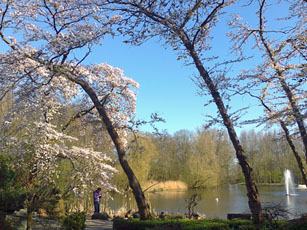 Amsterdam is home to magnificent Cherry and Magnolia trees, really massive big, blossoming trees, stunning on a clear spring day.
Amsterdam is home to magnificent Cherry and Magnolia trees, really massive big, blossoming trees, stunning on a clear spring day.
Then there's the Wisteria which thrives in Amsterdam. You'll see them climbing to the 3rd, 4th or 5th floor, curling and draping themselves around balconies and drainpipes.
Amsterdam isn't the only place on earth where the Wisteria thrives but their wow-factor here is the way they ‘reach for the sky’. You'll see how they appear to ‘rush’ up the high walls of houses.
However, the owners are up with the play and see to it that their Wisteria never gets above itself. With all the little attic windows and balconies, the inhabitants are able to reach out to snip and stop them so they never seem to cause a problem to roofs. The Dutch are kind of handy too, which helps;
Wisterias often grow out of tiny spaces too but when you see the size, weight and contortions of their trunks and branches you'll be astounded. The specimen on Amstel 169-171 is certainly worth a visit and you'll see how the owners have had to re-route the pipes around the sinewy trunk and branches.
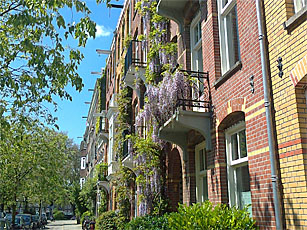
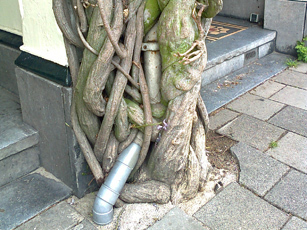
Better still, go on a ‘Wisteria Walk’ and see lots of them, and laburnum too. The way wisterias grow here in Amsterdam has to be experienced. No photo can do them justice, you have to stand under them and feel the awe! You have to look up at their height and smell their scent and you'll fly as high as if you’d got yourself stoned down the red-light district! It's much cheaper too and you can save your euros for a few glasses at one of our nice pavement cafés.
The Canals
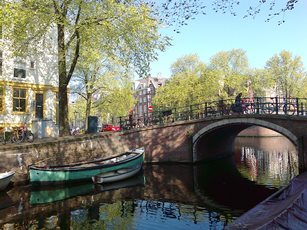 Take a look at any map of Amsterdam and you can see straight away that there's water everywhere. The canals span out from Central Station in a semi-circular pattern and are dissected in the centre by the Amstel River flowing from South East to the North West. There are numerous other smaller canals, and walking along canals is delightful in itself.
Take a look at any map of Amsterdam and you can see straight away that there's water everywhere. The canals span out from Central Station in a semi-circular pattern and are dissected in the centre by the Amstel River flowing from South East to the North West. There are numerous other smaller canals, and walking along canals is delightful in itself.
Most canals are relatively quiet for walking and because they form a network, you can veer away easily if there's a din somewhere. Furthermore all canals are lined with trees, mostly elm but there are lime trees, plane trees, poplars, cypresses all thriving beside the water. Leafy leafy lusciously leafy!
Pavement Gardens
Pretty much unique to Amsterdam, these miniscule flower & plant borders at the foot of the house-fronts enhance Amsterdam for us all. So tiny, these gardens are usually smaller than your desk but can be home to 10 metre high wisterias, cascading roses, forsythia, hollyhocks, clematis etc. Some are as small as a shoe-box but still hold their own. The precise translation would read ‘façade gardens’, but I feel that ‘pavement gardens’ describes them more aptly because they are there on the pavement for our enjoyment.
As I said before, in other countries the bins would be stowed here. But in Amsterdam people have so little space, they ‘maximize’ every nook. Being aware of these little gems is crucial to your enjoyment of any Leafy Walk in Amsterdam.

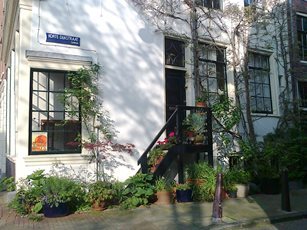
Pavement Gardens in spring
At the first whiff of spring out come the pavement gardeners pruning, digging, mulching and tossing out all the empty beer cans and litter caught in their plants.
These gardens do not flourish by magic and they take a lot of insults and beatings, being on the open street as they are.
Given a few days of warm sun and lots of TLC, dreary borders are transformed into budding beauty. You can walk and walk and you'll find them here, there, and everywhere.
Spring evening sounds are the blackbird and the clunk of trowel against brick and stone and hopefully the clink of glasses too.
The great advantage for us strolling around is that these gardens are totally at our disposal and not hidden behind walls or fences. We can enjoy as we go, marvel or even nitpick. There's no threshold to cross either, no need to ‘go in’ anywhere nor exchange pleasantries, if you don't feel inclined.
Neither do we have to pay anything, yes yes the best things in life really are free!
Trees in spring
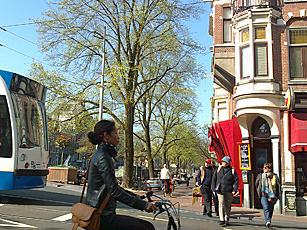 The Amsterdam canals would not be so beautiful without the elm. There are thousands of elms of different types in Amsterdam: along the canals and streets, standing in parks, greens, and squares. The elm is like the sun – everything looks fresher and nicer in its green glow.
The Amsterdam canals would not be so beautiful without the elm. There are thousands of elms of different types in Amsterdam: along the canals and streets, standing in parks, greens, and squares. The elm is like the sun – everything looks fresher and nicer in its green glow.
In spring, from about the second half of March, the elm seeds appear, although last year (2013) it was about a month later. The bare elm gets covered in pale green disc-shaped seeds which appear in little clusters or ‘posies’ on the branches. The effect resembles cherry blossom except that it is pale green instead of pink.
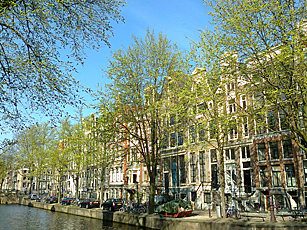 Although the elm (Ulmus) is dominant, there's a great variety of trees flourishing in this city; all combine to give us this glorious light green glow in spring. The limes (Tilia), the stands of majestic poplars (Populus) at strategic points. Weeping willow (Salix) on the waterfront near the Rijksmuseum for example, the plane trees (Platanus) and the way they lean, creating a lovely dappled overhang. You'll see swamp cypress (Taxodium), dawn redwood (Metasequoia), maidenhair (Ginkgo), Japanese pagoda tree (Sophora japonica) horse chestnut (Aesculus hippocastanum), birch (Betula), caucasian wingnut (Pterocarya fraxinifolia). It's a feast for the eyes (or ‘eye candy’ as they call it over the water).
Although the elm (Ulmus) is dominant, there's a great variety of trees flourishing in this city; all combine to give us this glorious light green glow in spring. The limes (Tilia), the stands of majestic poplars (Populus) at strategic points. Weeping willow (Salix) on the waterfront near the Rijksmuseum for example, the plane trees (Platanus) and the way they lean, creating a lovely dappled overhang. You'll see swamp cypress (Taxodium), dawn redwood (Metasequoia), maidenhair (Ginkgo), Japanese pagoda tree (Sophora japonica) horse chestnut (Aesculus hippocastanum), birch (Betula), caucasian wingnut (Pterocarya fraxinifolia). It's a feast for the eyes (or ‘eye candy’ as they call it over the water).
I've put in the latin names for the sake of accuracy and not to be smart. Because I've had to ferret them out from their Dutch names I found that the scientific names are more exact, common names can vary from place to place.
Where to quench your thirst?
Thirsty?
The sense of well-being will really peak when you're able to have a glass or cuppa outside in the sun especially if it's beside a canal. See our list of nice places along the walks. I always go kitted out with a jacket or something woolie/fleecie to allow me to stay outside for as long as possible. There can be a coldish wind at this time of year even on a nice day, but it's such a delight to be outside… sipping!
Hungry or thirsty? Or both?
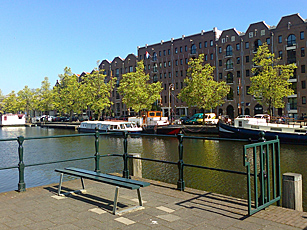 One thing I would suggest for daytime walks: if you don't like going to cafés for food or drinks all the time, or if your budget doesn't stretch, then bring your own!
One thing I would suggest for daytime walks: if you don't like going to cafés for food or drinks all the time, or if your budget doesn't stretch, then bring your own!
There are plenty places where you can buy freshly-made sandwiches (broodjes) or the pre-packed variety.
If you go before lunchtime rush-hour, the deli will be fairly quiet and most are happy to make you a cheese roll or whatever. The term ‘to go’ is widely-used here and a bread roll with cheese, ham etc is called a ‘broodje’ (pronounced: brode-je as in ..ode plus dje)
If you come across benches in delightful spots you'll be thrilled to tear in to your ‘picnic’ there at your leisure.
For pre-packed sandwiches, look in supermarkets like:
- Marqt – Utrechtsestraat near Rembrandtplein or Overtoom
- Marks & Spencers – Kalverstraat near Munt Plein
- Albert Heijn – all over the place
For freshly-made sandwiches (broodjes) try:
- Loekie, Utrechtsestraat
- Sterk Staaltje, Staalstraat
- Other delis, cheese shops that you see or are in your area
- Kiosks on street selling bread-rolls with fish, prawns, herring etc
- Small shops and cafés are often willing to make you a quick sandwich ‘to go’.
Nice pavement cafés for Coffee / Tea / Lunch / Beer / Wine / Dinner (CTLBWD)
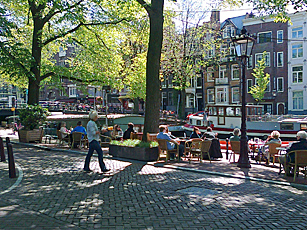 Most of these are easy to find once you know about them and link in to lots of the walks. There are places where you'll sit down outside a café on a soft evening and think ‘this is bliss’.
Most of these are easy to find once you know about them and link in to lots of the walks. There are places where you'll sit down outside a café on a soft evening and think ‘this is bliss’.
- Hermitage (nice in the mornings as it gets eastern sun, closes before 6) CTLBW
- Marcella – great all day, my fave outdoor café CTLBW
- De Groene Olifant – good position for lots of walks CTLBWD
- Café de Jaren, lovely spot, very central CTLBWD
- Nel - dappled shade beside playground CTLBWD
- Crea – great position on water CTBW
- Paninoteca Pizza & Prosecco- sunny corner LBWD
- Theehuis de Roos, garden Vondelpark CTL
- Van Rijn Rembrandtplein, very pleasant CTLBWD
- Café Smit en Voogt, friendly and handy, CTLBWD
… lots more to follow


Tired of Walking?
Having a public transport card (which may also get you into museums) is a good idea. If you're tired or cold or just want to explore a new area? Hop on a tram!
Trams are wonderful, they afford maximum visibility and if you go outside of rush hour, you'll even get a seat. If you make a mistake and go the wrong direction, just check out at next stop, cross to the other side and take the next tram going the other direction. Ez pz
